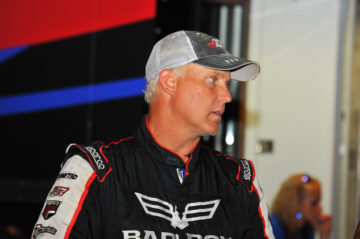It’s not exactly breaking news to point out that aerodynamics play a part in racing. However, the impact of the air on race cars that compete on short tracks has been somewhat discounted in the past. And further, the impact of air on Dirt Late Model cars has been considered even less important … until the last few years.
During his recent run of wins, driver Dale McDowell stated in a post-race interview that his team was beginning to work more on aerodynamics and develop an even greater understanding of how to control the air as it moves onto and around the car.
“I think it’s definitely a lot more important today than it was a couple of years ago,” McDowell explained in an interview with InsideDirtRacing.com. “With some of the packages we’re running now, these cars are more rigid and there’s more forced grip, you know, more mechanical grip, and when you do that, I feel like the air is more important because of needing to get all the loads balanced. Then when you get out of that good air your race car does different things because it unloads quicker.”
But the changes regarding aerodynamics are inevitable according to McDowell. And more, those who make the rules are charged with a virtually impossible task when it comes to regulating the many components on a Dirt Late Model race car.
“It’s just the nature of the beast, but I think the sanctioning bodies have got their work cut out for them as far as keeping up with the technology that’s out there to be able to police it,” the veteran driver asserted. “We don’t want to get to the point where we have to build a different car for a different series.”
Having been a racer for a number of years, the 51-year-old driver has an understanding of what Dirt Late Models used to feel like and what they feel like today. So how are the cars different today from what they felt like ten years ago?
“It’s a lot more rigid,” McDowell pointed out. “You have to drive the cars a lot harder now. It used to be that when the race tracks would get slicker you’d kind of relax, but now with the packages that most of the guys have, you’ve really got to hustle the cars. You feel every bump on the race track when the cars are more rigid like that. It’s changed a lot in the last couple of years with the direction it’s going. The racing is still good so I think it’s just a product of everything evolving and the technology trickling down to our level.”
In the 1990’s the term aero-tight, or aero-push, emerged in the NASCAR ranks to describe the situation in which a trailing car becomes more difficult to steer when following behind another car that has ‘clean air’, or undisturbed air, at its disposal. McDowell says that condition has now made its way into dirt racing due to the advancement of the bodies, shocks, springs and other components on the cars and the ability to make the greatest use of the air.
“You’ll definitely see that,” McDowell described of the aero-push condition. “For the folks out there that don’t know what to look for- a slide job for instance- if you see somebody slide across another driver’s nose and you see the car push, it’s because of the disrupted air on the car that just got passed. Obviously, the bigger race tracks are more affected than the smaller tracks, but we can even feel it on 3/8 mile stuff now. The cars are more sealed off in the front end now. When all that is in its place, then any kind of disruption makes it move and it just changes everything.”
As a result, McDowell says the lead car has an advantage over the field, but that advantage may not be as great as in NASCAR or other forms of racing.
“I don’t know if it’s a huge advantage because in our world of dirt track racing there are usually multiple grooves so you can just go somewhere to try to get clean air. You may duck under a guy or on the outside of a guy. But definitely when you come up on a pack of cars you feel it more whether you started in the back and are coming to the front or if you’re the leader and you’re lapping cars.”








